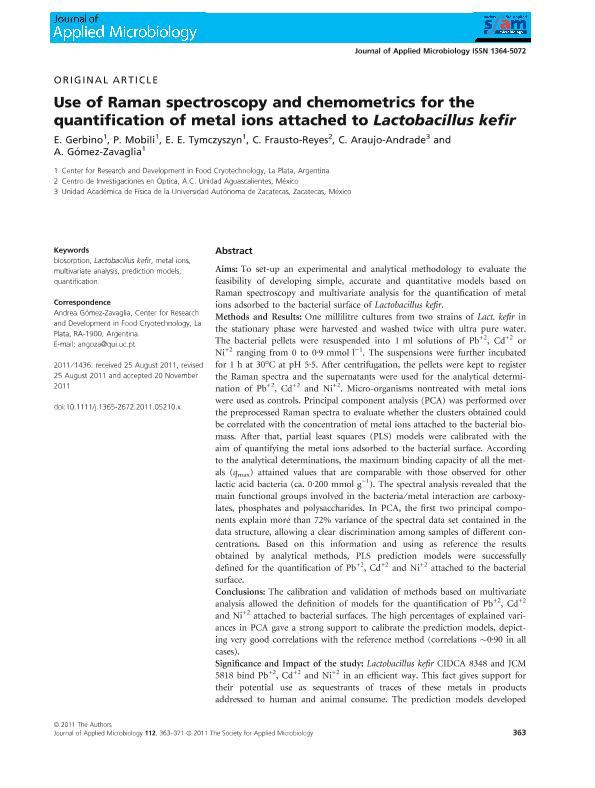Mostrar el registro sencillo del ítem
dc.contributor.author
Gerbino, Oscar Esteban

dc.contributor.author
Mobili, Pablo

dc.contributor.author
Tymczyszyn, Emma Elizabeth

dc.contributor.author
Frausto Reyes C.
dc.contributor.author
Araujo Andrade C.
dc.contributor.author
Gomez Zavaglia, Andrea

dc.date.available
2020-04-23T14:11:06Z
dc.date.issued
2012-02
dc.identifier.citation
Gerbino, Oscar Esteban; Mobili, Pablo; Tymczyszyn, Emma Elizabeth; Frausto Reyes C.; Araujo Andrade C.; et al.; Use of Raman spectroscopy and chemometrics for the quantification of metal ions attached to Lactobacillus kefir; Wiley Blackwell Publishing, Inc; Journal of Applied Microbiology; 112; 2; 2-2012; 363-371
dc.identifier.issn
1364-5072
dc.identifier.uri
http://hdl.handle.net/11336/103424
dc.description.abstract
Aims: To set-up an experimental and analytical methodology to evaluate the feasibility of developing simple, accurate and quantitative models based on Raman spectroscopy and multivariate analysis for the quantification of metal ions adsorbed to the bacterial surface of Lactobacillus kefir. Methods and Results: One millilitre cultures from two strains of Lact. kefir in the stationary phase were harvested and washed twice with ultra pure water. The bacterial pellets were resuspended into 1 ml solutions of Pb+2, Cd+2 or Ni+2 ranging from 0 to 0Æ9 mmol l)1 . The suspensions were further incubated for 1 h at 30C at pH 5Æ5. After centrifugation, the pellets were kept to register the Raman spectra and the supernatants were used for the analytical determination of Pb+2, Cd+2 and Ni+2. Micro-organisms nontreated with metal ions were used as controls. Principal component analysis (PCA) was performed over the preprocessed Raman spectra to evaluate whether the clusters obtained could be correlated with the concentration of metal ions attached to the bacterial biomass. After that, partial least squares (PLS) models were calibrated with the aim of quantifying the metal ions adsorbed to the bacterial surface. According to the analytical determinations, the maximum binding capacity of all the metals (qmax) attained values that are comparable with those observed for other lactic acid bacteria (ca. 0Æ200 mmol g)1 ). The spectral analysis revealed that the main functional groups involved in the bacteria ⁄ metal interaction are carboxylates, phosphates and polysaccharides. In PCA, the first two principal components explain more than 72% variance of the spectral data set contained in the data structure, allowing a clear discrimination among samples of different concentrations. Based on this information and using as reference the results obtained by analytical methods, PLS prediction models were successfully defined for the quantification of Pb+2, Cd+2 and Ni+2 attached to the bacterial surface. Conclusions: The calibration and validation of methods based on multivariate analysis allowed the definition of models for the quantification of Pb+2, Cd+2 and Ni+2 attached to bacterial surfaces. The high percentages of explained variances in PCA gave a strong support to calibrate the prediction models, depicting very good correlations with the reference method (correlations 0Æ90 in all cases). Significance and Impact of the study: Lactobacillus kefir CIDCA 8348 and JCM 5818 bind Pb+2, Cd+2 and Ni+2 in an efficient way. This fact gives support for their potential use as sequestrants of traces of these metals in products addressed to human and animal consume. The prediction models developed would be useful for the determination of the investigated metal ions in unknown samples giving at the same time, structural information about this interaction. This is certainly the most important contribution of this work.
dc.format
application/pdf
dc.language.iso
eng
dc.publisher
Wiley Blackwell Publishing, Inc

dc.rights
info:eu-repo/semantics/openAccess
dc.rights.uri
https://creativecommons.org/licenses/by-nc-sa/2.5/ar/
dc.subject
BIOSORPTION
dc.subject
LACTOBACILLUS-KEFIR
dc.subject
METAL-IONS
dc.subject
MULTIVARIATE-ANALYSIS
dc.subject
PREDICTION-MODELS
dc.subject
QUANTIFICATION
dc.subject.classification
Biología Celular, Microbiología

dc.subject.classification
Ciencias Biológicas

dc.subject.classification
CIENCIAS NATURALES Y EXACTAS

dc.subject.classification
Óptica

dc.subject.classification
Ciencias Físicas

dc.subject.classification
CIENCIAS NATURALES Y EXACTAS

dc.title
Use of Raman spectroscopy and chemometrics for the quantification of metal ions attached to Lactobacillus kefir
dc.type
info:eu-repo/semantics/article
dc.type
info:ar-repo/semantics/artículo
dc.type
info:eu-repo/semantics/publishedVersion
dc.date.updated
2020-04-22T15:33:01Z
dc.journal.volume
112
dc.journal.number
2
dc.journal.pagination
363-371
dc.journal.pais
Reino Unido

dc.journal.ciudad
Londres
dc.description.fil
Fil: Gerbino, Oscar Esteban. Provincia de Buenos Aires. Gobernación. Comisión de Investigaciones Científicas. Centro de Investigación y Desarrollo en Criotecnología de Alimentos. Consejo Nacional de Investigaciones Científicas y Técnicas. Centro Científico Tecnológico Conicet - La Plata. Centro de Investigación y Desarrollo en Criotecnología de Alimentos. Universidad Nacional de la Plata. Facultad de Ciencias Exactas. Centro de Investigación y Desarrollo en Criotecnología de Alimentos; Argentina
dc.description.fil
Fil: Mobili, Pablo. Provincia de Buenos Aires. Gobernación. Comisión de Investigaciones Científicas. Centro de Investigación y Desarrollo en Criotecnología de Alimentos. Consejo Nacional de Investigaciones Científicas y Técnicas. Centro Científico Tecnológico Conicet - La Plata. Centro de Investigación y Desarrollo en Criotecnología de Alimentos. Universidad Nacional de la Plata. Facultad de Ciencias Exactas. Centro de Investigación y Desarrollo en Criotecnología de Alimentos; Argentina
dc.description.fil
Fil: Tymczyszyn, Emma Elizabeth. Provincia de Buenos Aires. Gobernación. Comisión de Investigaciones Científicas. Centro de Investigación y Desarrollo en Criotecnología de Alimentos. Consejo Nacional de Investigaciones Científicas y Técnicas. Centro Científico Tecnológico Conicet - La Plata. Centro de Investigación y Desarrollo en Criotecnología de Alimentos. Universidad Nacional de la Plata. Facultad de Ciencias Exactas. Centro de Investigación y Desarrollo en Criotecnología de Alimentos; Argentina
dc.description.fil
Fil: Frausto Reyes C.. Centro de Investigaciones en Óptica; México
dc.description.fil
Fil: Araujo Andrade C.. Universidad Autónoma de Zacatecas; México
dc.description.fil
Fil: Gomez Zavaglia, Andrea. Provincia de Buenos Aires. Gobernación. Comisión de Investigaciones Científicas. Centro de Investigación y Desarrollo en Criotecnología de Alimentos. Consejo Nacional de Investigaciones Científicas y Técnicas. Centro Científico Tecnológico Conicet - La Plata. Centro de Investigación y Desarrollo en Criotecnología de Alimentos. Universidad Nacional de la Plata. Facultad de Ciencias Exactas. Centro de Investigación y Desarrollo en Criotecnología de Alimentos; Argentina
dc.journal.title
Journal of Applied Microbiology

dc.relation.alternativeid
info:eu-repo/semantics/altIdentifier/url/http://onlinelibrary.wiley.com/doi/10.1111/j.1365-2672.2011.05210.x/abstract
dc.relation.alternativeid
info:eu-repo/semantics/altIdentifier/doi/https://doi.org/10.1111/j.1365-2672.2011.05210.x
dc.relation.alternativeid
info:eu-repo/semantics/altIdentifier/url/https://pubmed.ncbi.nlm.nih.gov/22129226/
Archivos asociados
